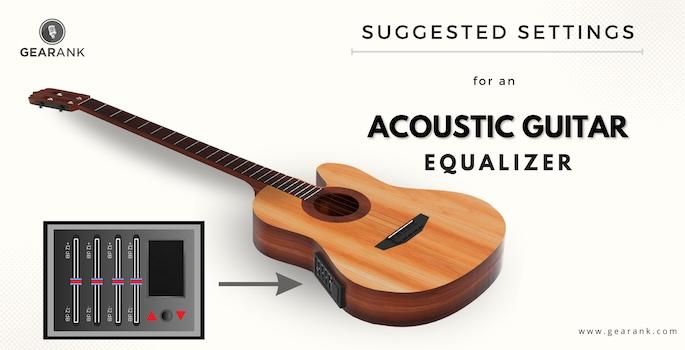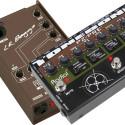Acoustic Guitar EQ - Start with Our Suggested Settings

Tweaking acoustic guitar EQ is one of the first steps to sounding good, be it for live performance or for recordings.
You have so many tools to apply EQ, and it's not that hard to do. You can see EQ controls in acoustic preamps, pedals, mixers, amps, DAW software, and more,
To make the most of the abundance of EQs, the key is proper utilization.
This comprehensive guide will take you through the ins and outs of the EQing process, specifically tailored for acoustic guitars.
When used properly, EQ is an incredibly powerful tool for tone shaping and addressing frequency imbalances.
You'll learn
-
What is Equalization
-
Benefits of Good Acoustic Guitar EQ
-
How to EQ an Acoustic Guitar (Step by Step)
-
Tips for EQing live acoustic guitar sound
Let's start it off with a quick definition of what Equalization is.
What is Equalization
Equalization refers to the adjustment of frequencies in audio. It is a form of signal processing used to create a more balanced and consistent output.
More advanced EQs let you control specific frequencies.
And now, let's see how this signal processing applies to acoustic guitars.
Benefits of Good Acoustic Guitar EQ
Acoustic guitars produce a wide range of frequencies, from low-end boomy tones to punchy and percussive attack, to bright and shimmering highs.
To make these unique sonic characteristics sound good on stage and sit well in a mix, some adjustments to the acoustic guitar frequency range must be made.
You can use EQ to boost deficient frequencies and reduce excessive ones. In-band settings, it can make room in the mix for other instruments.
Knowing how to use EQ properly is required for both live performance and recording, you need it to craft a polished and balanced sound.
Some of the most common uses of EQ are outlined below.
Tone shaping
Every acoustic guitar has unique tonal characteristics, EQ lets you shape the guitar's frequency response by boosting or cutting specific frequency ranges. Maybe you want more bottom end, or you want more You can use it to emphasize the guitar's strengths and address any issues in its tone.
Feedback control
Acoustic guitars are prone to feedback, especially when amplified at high volumes. You can use EQ to zero in on problematic frequencies to attenuate the ones that are prone to feedback.
By identifying and attenuating these frequencies, you can achieve a cleaner and more controlled sound.
Balance in a Mix
For live performances and recording sessions, it's crucial to ensure that the acoustic guitar sits well in the overall mix. EQing helps to carve out a space for the guitar within the frequency spectrum, preventing it from getting lost or overpowering the vocals and other instruments.
Now that you know the most common uses, let's dive into the meat of the topic: How to EQ an acoustic guitar.
How To EQ Acoustic Guitar (Step By Step)

Here are simple to follow steps to keep in mind when using EQ for an acoustic guitar.
Step 1
Start with a flat EQ. Set all the EQ controls on your guitar amplifier or mixer to neutral or flat positions. This ensures that you have a clean slate to work with.
Step 2
Next up, it's time to fix any inherent tonal issues. To do this, play your guitar and listen for any tonal imbalances.
If your guitar sounds too muddy or boomy, you might want to reduce the low frequencies (bass) using the low EQ control.
If it sounds too thin or lacking presence, you can boost the midrange frequencies. Cut or boost frequencies as needed.
Step 3
Most acoustic guitars are prone to feedback. And EQ is a great tool to manage this issue. If you're experiencing feedback issues, you can use EQ to identify the offending frequencies.
Slowly sweep the EQ controls (especially the midrange and high frequencies) while playing your guitar until you notice the feedback becoming more prominent. Once you've identified the problematic frequencies, reduce them using the corresponding EQ controls. This method won't work with single tone knob equalizers.
Step 4
Now it's time to add some clarity and presence. Boosting the high frequencies can add sparkle and clarity to your guitar sound. Experiment with the high EQ control, but be cautious not to overdo it, as excessive boosting can result in harsh or brittle tones. Too much highs can also cause squeaks, buzz, and other acoustic guitar string noise-related issues
Step 5
The final thing to do is to experiment and refine the sound you have created. Although some things are considered standard for all musicians and audio engineers, there is some leeway for customized tone shapes, depending on the guitar you're using or your playing style.
For acoustic-electric guitars, EQ can target the Quack sound of piezo pickups. This usually involves using sweepable midrange control and attenuating the offending frequencies, usually by big margins.
Take the time to experiment with different EQ settings and listen carefully to the changes in tone. Make small adjustments until you achieve a balanced and pleasing sound.
How To EQ An Acoustic Guitar For Live Performances
Live Performances offer their own set of unique difficulties around creating a balanced and equalized sound. With this in mind, you should know that you should also try to equalize your acoustic guitar when setting up for a performance.
What follows is a short guide to acoustic guitar EQing within a performance setting.
Perform Sound Checks: Before a live performance, take the time to do thorough sound checks. Play your rhythm guitar part and have someone listen from various positions in the venue.
Depending on the feedback you get, change the EQ settings. Ensure the guitar fits well into the overall mix by paying attention to how it interacts with other instruments.
Communicate With The Sound Engineer: If you're performing with a professional sound engineer, communicate your preferences and concerns regarding the acoustic guitar sound. To optimize the sound for the space, they can offer helpful advice and make EQ adjustments from the front-of-house or monitor console.
Use A Soundhole Cover: By dampening the guitar's resonant frequencies, a soundhole cover can aid in reducing feedback. It's especially helpful when you are performing with amplifiers or high volumes.
Use A Notch Filter: Many acoustic guitar preamps and DI boxes feature a notch filter, which allows you to target and cut a specific problematic frequency.
Apply the notch filter to reduce the problem if feedback occurs frequently at a specific frequency.
Consider Using A Parametric EQ: Parametric EQs offer more precise control over frequency adjustments. They let you pick a particular frequency band and modify its level, bandwidth, and Q-factor.
When dealing with feedback or specific tonal issues during live performances, this level of control can be helpful.
Monitor Your Sound: Confer with the sound engineer to set your personal monitor mix properly. This way, you can hear yourself and the band clearly through stage monitors or in-ear monitors.
Adapt: Each performance venue will have its room acoustics. Be ready to modify your EQ settings according to the size, shape, and materials of the room.
Pay attention to the guitar's resonance in the room and make any necessary adjustments.
Important Frequency Ranges To Look At When EQing An Acoustic Guitar
In order to achieve a well-balanced and pleasing sound when EQing an acoustic guitar, there are a few areas of the frequency spectrum that you should pay attention to. Remember that depending on the type and style of guitar playing you practice, some of these may be more or less significant.

Low frequencies (Bass)
Low frequencies (80-300Hz) add fullness and low-end support to the overall guitar sound. However, over-exaggeration of bass frequencies can lead to muddy or boomy guitar tones. If the acoustic guitar's clarity is lacking, or it has too much low-end resonance, pay attention to the low-end and consider lowering the frequencies below 80 Hz. If the guitar sounds too thin, then consider incrementally lifting this frequency band. Just remember not to overdo the sub bass, so you don't overpower low frequency sounds like the kick drum and bass instruments.
Low-mid frequencies
The thickness and warmth of the guitar sound are influenced by this range, which typically falls between 100 Hz and 500 Hz. Finding the right balance in this area is crucial because too much of either can make the guitar sound muddy or overly thick, while too little will produce a thin or weak sound. To achieve the desired amount of warmth and body, adjust the EQ controls within this range.
Mid range frequencies
The fundamental character and articulation of the acoustic guitar are found in the midrange, which spans frequencies from 500 Hz to 2 kHz. The tonal characteristics of the guitar can be significantly altered by boosting or cutting particular frequencies within this range. To add presence and clarity, try gentle boosts at 800 Hz, or if the guitar sounds nasal or honky, try subtle cuts at 1.5 kHz. Note that this is the same frequency space that vocals operate in, so be frugal when boosting mid frequencies in a band setting.
High-mid frequencies
The attack, definition, and presence of the guitar sound are produced by the high-mid frequencies, which are centered between 2 and 5 kHz. By upping these frequencies, you can enhance the guitar's articulation and make the guitar jump out more in a mix. However, overdriving this range with a boost can produce harsh or piercing tones. To add definition and clarity without sounding too bright or sibilant, strike a balance.
High frequencies (treble)
The acoustic guitar sound's sparkle, brilliance, and general clarity are all influenced by this high-frequency range. Increasing the high frequencies can give the guitar more air and presence, which will stop it from sounding thin.
Be careful not to overdo it, though, as doing so too much can add unwelcome harshness or make the guitar sound brittle. This can also increase acoustic guitar string noise and fretting noise.
Obtain a pleasing balance by adjusting or cutting frequencies in this segment subtly.
Final Thoughts
EQing an acoustic guitar is a valuable skill that can enhance your playing experience. More importantly, it can improve the overall sound quality of your performance or recording.
With the principles provided, you can effectively utilize acoustic guitar EQ to address tone issues and achieve great-sounding acoustic tones.
Now, to answer some of the common questions regarding acoustic guitar equalization.
Frequently Asked Questions
Can I Use A Graphic EQ Pedal For An Acoustic Guitar?
Yes, a graphic EQ pedal gives you more precise control over your acoustic guitar's tone. You can amplify or attenuate frequency bands as needed.
How Can I Prevent Feedback?
In addition to EQing, there are a few other methods for avoiding feedback. Feedback can be minimized by using a soundhole cover, moving away from speakers, and moving away from microphones. Proper mic stand positioning and mic placement on stage can help prevent feedback issues. Other tools that can help with feedback include phase shift, noise gates, and simple volume control. Some digital and analog mixers come with feedback suppressors that can also be utilized.
Should I EQ My Acoustic Guitar Sound Differently For Live VS Recording?
Yes, the EQ settings used for live performance and recording process can vary. You can fine-tune the environment and the mixing process more easily on an acoustic guitar track on post production.
When performing live, you must take into account the setting, additional instruments, and the overall sound mix.
Is It Necessary To EQ Acoustic Guitars If They Already Sound Good?
Not always. There might not be a need for significant EQ adjustments if your acoustic guitar already sounds balanced at flat EQ settings. However, small adjustments can still improve the sound and take care of any minor tonal issues that might occur in various settings.
EQing acoustic guitar can be difficult if you are taking part in a live performance, so make sure that you listen carefully and smooth out anything that does not sound natural.
What are the best EQ settings for acoustic guitar?
V-shape EQ curve is great for a singer-songwriter track style track. And it's also ideal for those who want to emphasize the lows and highs without crowding the vocal frequencies. While a reverse U shape would be good for emphasizing musical phrases that cut through the mix.
For best results, the shape has to retain a close to flat shape, boost/cut differences between frequency bands should not be exaggerated.
Can I Use The Same EQ Settings For Different Guitars, Including A Bass Guitar?
Each guitar will have a different set of specific traits and tonal qualities, even though some general EQ principles may be applicable.
To account for each guitar's unique characteristics, it is best to approach EQing individually.
Should I EQ An Acoustic Guitar Before Or After Adding Effects?
In general, EQing the guitar is advised before applying effects. Effects can be used to further enhance or modify the instrument's fundamental tone after EQing has helped shape it.
Is It Important To EQ Electric Guitars?
Compared to an acoustic, the electric guitar has a distinct guitar tone. So you have to target different frequencies. The process is similar, but electric guitars allow for more pronounced EQ shapes. Electric guitars also have more complex signal chains that may include more EQ options like a low pass filter and a high pass filter.
Contributors:
Jerry Borillo - Illustrator












